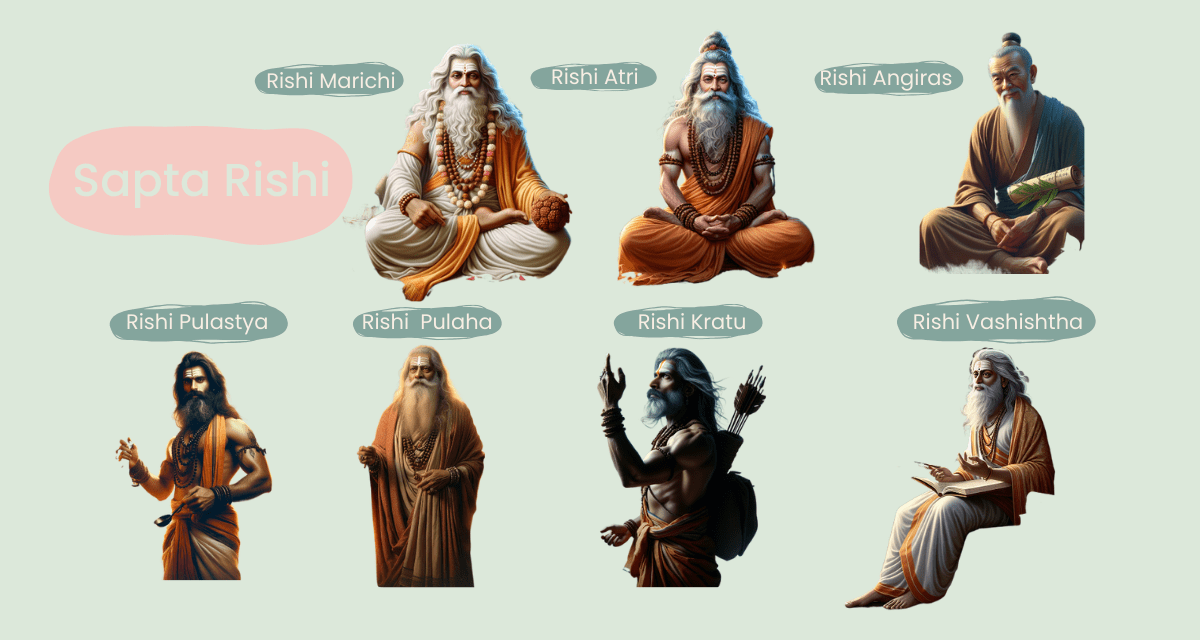Main Seven Indian Sages
According to The Hindu mythology and cosmology, Brahma created the Saptarishi, the seven sages, to support him in the complex process of creation and to preserve the knowledge of the universe.
The seven sages had the following tasks:
Assistance in Creation:
-
Brahma was the primary creator and he needed assistance in the complex process of creating and populating the universe.
-
The Saptarishi were helpful in generating various species, and guiding human civilization.
-
They were ensuring the spread of Dharma (cosmic law) and knowledge
Spreading and preservation of Veda (Vedic knowledge):
-
The Saptarishi were the Rishis who received the Vedic hymns and knowledge through divine inspiration. They composed and compiled these hymns and knowledge.
-
The Saptarishi were passing these Vedic hymns and knowledge orally from generation to generation.
-
They were responsible for sharing, spreading, and preserving the Vedas, including the rituals, mantras, spiritual and the sacred hymns which are essential to maintain the cosmic balance.
Establishment and maintain the Dharma:
-
They were ensuring the cosmic order established, and maintained in universe.
-
The Saptarishi played a very important role in bringing or set the ethical and moral guidelines for humanity and other beings to live in harmony.
Spiritual Guidance:
-
They were providing the spiritual guidance to humanity for their well-being and evolution.
-
The Saptarishi with their great wisdom and spiritual expertise were able to fulfill this role.
Guidance to Kings and Society:
-
The Saptarishi played an important role as advisors to kings, rulers and society to help them to govern the society and uphold on the Dharma.
-
Their knowledge and guidance was very crucial in maintaining the society order. They were ensuring that kings and rulers follow the moral and righteous principles.
Performers Yajnas (Sacrificial Rituals):
-
The Saptrishis performed various Yajnas, these were essential rituals for pleasing the gods, maintaining cosmic balance, and ensuring prosperity.
-
These rituals were a central aspect of Vedic culture.
Mediators between Gods and Humans:
-
The Saptarishi were acting as intermediaries between the gods and humans, passing divine messages and ensuring that humans follow divine laws.
-
They shared many different techniques of meditation which helped to maintain harmony between the divine and worldly realms.
Examples of Idea conduct:
-
The lives and actions of the Saptarishi served as ideal models of ideal conduct, spirituality and devotion.
-
They have demonstrated to people how to live in accordance with Dharma and attain spiritual enlightenment.
How the Saptarishi came?
Brahma’s Tapas and meditation:
Brahma started a deep meditation to understand the process of creation.
First, he created the four kumaras from his mind. These four kumaras are Sanaka, Sanandana, Sanatana, and Sanatkumara. These four kumaras are celibate and eternal sages who choose to remain in the state of perpetual childhood and dedicated to continue to pursue the spiritual knowledge and did not want to tangle in the material world.
Brahma felt the need of more beings in the creation and cosmic activities.
Brahma started to meditate again and from different parts of his body, the seven great sages (the Saptarishi) are born.
-
Sage Marichi emerged from Brahma's mind.
-
Sage Atri emerged from Brahma's eyes.
-
Sage Angiras emerged from Brahma's mouth.
-
Sage Pulastya emerged from Brahma's ears.
-
Sage Pulaha emerged from Brahma's navel.
-
Sage Kratu emerged from Brahma's hand.
-
Sage Vashishtha emerged from Brahma's breath.
In some other versions of the myth, Brahma created the Saptarishi from different aspects of his mind, they were born from his thoughts rather than specific body parts.
Sage Marichi

-
Maharishi Marichi, one of the mind-born sons of Brahma. His main contribution was in the Rigveda. There he wrote several hymns, where he is revered for his profound spiritual insights and his role as a Vedic seer.
-
His work in creation extended to establishing cosmic order and principles of Dharma through his teaching. His legacy in Dharma is connecting of the promotion of Vedic rituals and spiritual wisdom.
-
He conveys the knowledge and guided early humans. He ensured that the principles of Dharma were deeply rooted in the emerging civilization. He contributed to the establishment of the ethical and spiritual foundation of society. He also played an important role in the creation of life. He was responsible for generating progeny that would populate the universe.
-
He is known as a father of Sage Kashypa, who was the very important key figure in the propagation of various life forms like gods, humans, demons and other creatures.
Sage Atri

-
Sage Atri, born from Brahma's eyes and known as one of the most admired and respected vedic sages. He gave numerous hymns in the Rigveda.
-
His work in Dharma involves guiding kings and his disciples, he always drew attention to the importance of righteousness and moral rules.
-
Through his intense tapas and meditation, he set an example of spiritual discipline and helped spreading Vedic wisdom. His teachings brought balance between duty, spirituality and morality. He contributed in the holistic development of Vedic society.
-
He helped to populate the universe. Sage Atri and his wife Anusya had three illustrious sons: Dattatreya, Durvasa, and Soma.
-
Dattatreya human form of the combined essence of Bramha, Vishnu and Mahesh, symbolizing the unity of creation, preservation and destruction.
-
Durvasa is known for his fiery temperament and his ability to give both blessing and curses, influencing cosmic order.
-
Soma is associated with the moon and played an important role in regulating time and the lunar calendar.
Sage Angiras

-
Maharishi Angiras emerged from lord Brahma's mouth. He was a vital figure in the spreading of Vedic knowledge and rituals.
-
Angiras was instrumental in the creation of various astronomical, holy, saintly beings and human lineages.
-
His descendants are known as the Angirasa. They continued his legacy and played a significant role in Vedic teachings and rituals.
-
Maharishi Angira’s contributions to the Rigaveda include various hymns that reflect his deep spiritual insights as a mediator between gods humans.
-
He was often on call in prayers during Yajnas (rituals) where his presence ensured the success of prayers and offerings to the deities.
-
He guided various kings and Sages to help them to maintain the principles of Dharma in their kingdom and teachings.
-
He was teaching how to live in harmony with cosmic laws and the natural order. His steady commitment to preserve the ethical codes and spiritual wisdom was remarkable.
Sage Pulastya

-
Sage Pulastya emerged from Brahma's ears. He holds a significant role in Hindu mythology as a creator and a transmitter of the Vedas as well.
-
Pulastya contributed to the creation various beings including the Rakshasas (demons) and the most powerful beings in the universe.
-
His child was Vishrava, who was the father of Kuber (the god of wealth) and Ravana (the demon king of Sri Lanka).
-
Pulastya played an important role and had strong influence in shaping the cosmic balance between good and evil.
-
In the terms of Dharma, Sage Pulastya contributed to passing on the Puranas, that contain a wealth of mythology, history, and spiritual knowledge.
-
Puranas are the texts that serve as a guidelines to live a life with Dharma. He guided his disciples to understand the importance of Dharma and to maintain the cosmic order.
-
His work has a strong and long lasting impact on Hindu spiritual traditions.
-
He helped to preserve the vital knowledge and traditions that they have been still practiced in this modern time period.
Sage Pulaha

-
He was born from Brahma's Nabi (navel center).
-
Pulaha was responsible for generating various species also and maintaining the continuity of the life.
-
His role was in creation to be ensuring to have diversity and stability of the world.
-
Rishi Pulaha is mentioned in the Vedas as a sage who contributed to the structure and preserves the Vedic knowledge.
-
In terms of Dharma his significance was on simplicity, austerity and spiritual discipline.
-
He taught his disciples the importance of living a life which is dedicated to spirituality, maintaining moral integrity, and adhering to Dharma.
Sage Kratu

-
Sage Kratu emerged from Brahma's hand.
-
Kratu was involved in the generation of various life forms and contributed into the diversity with balance of creation.
-
He was very popular for Yajas (sacrificial rituals). Kratu is credited with composing hymns and prayers in the Vedas and especially in the Rigveda.
-
He was known for his expertise in performing Yajnas and ensuring that these rituals were conducted according to the Vedic principles. These rituals were not only ceremonies but were seen as essential for maintaining the cosmic order.
-
As a spiritual teacher, he guided sages, disciples and even kings to understand and implementation of the principles of Dharma.
-
His teachings were very much focused on the importance of righteousness, morality and spirituality to live in harmony with nature and cosmic laws.
Mahrishi Vashistha

-
Sage Vashistha emerged from Brahma's breath. He known as one of the most admired sages in Hindu tradition.
-
He served as a royal priest, who was the advisor of King Dasharatha (the father of lord Rama).
-
Sage Vashistha was not only a priest but also a respected and well known Guru. He established an ashram where he was teaching numerous disciples and truth seekers.
-
His teachings were focused on living a life in harmony with cosmic order and follow the dharma.
-
He contributed numerous hymns in the Rigveda that shows his deep spiritual knowledge and his role as a Vedic Guru.
-
His dialogues with lord Rama are documented in the Yoga Vashistha which provide profound spiritual and philosophy knowledge.
-
His teachings still inspire, motivate and influence spiritual practice in Hinduism.
What are the key roles of the seven sages?
Sage Marichi: Known as a Prajapati, Marichi is the progenitor of Kashyapa and symbolizes the cosmic light and creation.
Sage Atri: Revered for his wisdom and devotion, Atri is credited with significant contributions to the Rigveda and is the father of the deity Dattatreya.
Sage Angiras: Angiras is recognized for his extensive hymns in the Rigveda and his association with fire and rituals.
Sage Pulastya: Esteemed as a transmitter of sacred knowledge, Pulastya is notable for his role in the genealogies of significant mythological figures like Ravana.
Sage Pulaha: Celebrated for his asceticism and penance, Pulaha is instrumental in preserving dharma through his lineage.
Sage Kratu: Renowned for his dedication to Vedic rituals, Kratu is a sage of deep devotion and sacrificial practices.
Sage Vashishtha: Highly regarded as a royal guru, Vashishtha is known for his profound wisdom, guidance to kings, and contributions to spiritual texts like the Yoga Vashishtha.
All are sons of Brahma but play different roles in mythological narratives.
-
Contributions: Their contributions vary from composing Vedic hymns to advising kings and engaging in rituals.
-
Attributes: Each sage is associated with specific qualities like light (Marichi), wisdom (Atri), fire and rituals (Angiras), sacred Knowledge (Pulastya), preservation of dharma (Pulaha), penance (Kratu), and royal guidance (Vashishtha).
Legends: Their individual legends and stories highlight their unique roles and significance within Hindu tradition.


